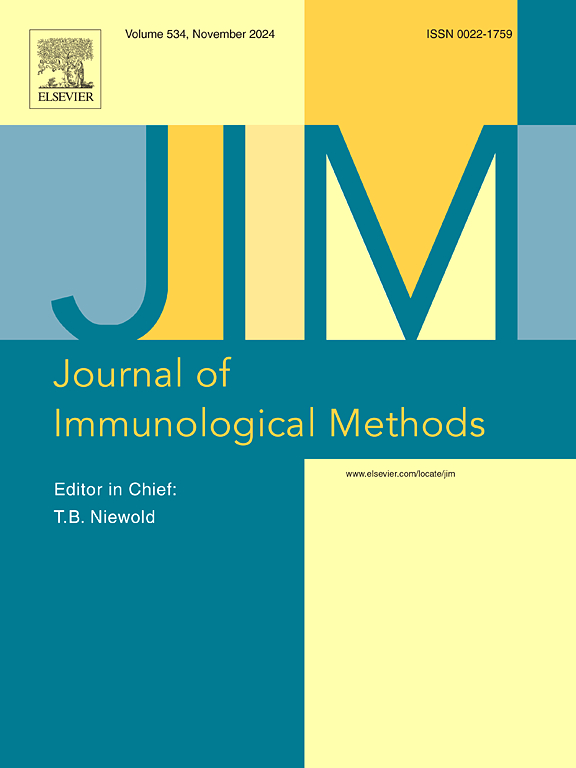Development of a novel and broadly applicable sandwich ELISA assay based on rabbit single-chain variable fragments and a modified Ig-binding domain of protein L fused to a polystyrene-binding peptide
IF 1.6
4区 医学
Q4 BIOCHEMICAL RESEARCH METHODS
引用次数: 0
Abstract
Most of currently available sandwich-type enzyme-linked immunosorbent assays (ELISA) require the use of full-length animal-derived antibodies which poses welfare criticisms and are often expensive to produce. There is therefore a strong demand for the development of more affordable and animal-free methods to produce antibodies for sandwich ELISA assay. To address these issues, we propose here the development of a new technology based on two complementary rabbit single-chain variable fragments (scFvs) and an Ig-binding domain of protein L (PpL1) fused to a polystyrene-binding peptide (PS-tag) that can be recombinantly produced in bacteria. Toward this goal, we developed a rabbit scFv capable to bind the antigen via its variable regions while engaging protein L through its constant framework domain. To enhance the density of captured scFv and enable a better solvent exposure, we generated multiple PpL1 variants bearing polystyrene-binding peptides (PS) tags fused to its ends. The tandem trimer of PpL1 variant bearing PS-tags located at the N-terminus (PpL1′-T-PSN) revealed increased antigen-binding signal when immobilized on hydrophilic polystyrene (phi-PS) plates. By CDR-grafting different antigen-binding specificities into our engineered protein L-binding scFv we validated our technology against a different antigen. Finally, to further enhance the sensitivity of our assay, we implemented a protein L-based pretreatment to remove potential inhibitory immunoglobulin often present in the blood samples. The ability to rapidly and cost-effectively generate animal-free recombinant antibody fragments that can be adsorbed and specifically oriented on plates while retaining their antigen-binding properties could lead to the development of innovative and widely applicable sandwich ELISA systems for the efficient, versatile and sensitive detection of different types of antigens.
基于兔单链可变片段和与聚苯乙烯结合肽融合的蛋白 L 的改良 Ig 结合域,开发出一种新型的、可广泛应用的夹心酶联免疫吸附测定法。
目前,大多数夹心酶联免疫吸附测定法(ELISA)都需要使用全长的动物源抗体,这不仅会带来福利问题,而且生产成本往往很高。因此,人们强烈要求开发更经济实惠且不使用动物的方法来生产用于夹心酶联免疫吸附测定的抗体。为了解决这些问题,我们在此提议开发一种新技术,该技术基于两个互补的兔单链可变片段(scFvs)和一个融合了聚苯乙烯结合肽(PS-tag)的蛋白质 L(PpL1)的 Ig 结合域,可在细菌中重组生产。为了实现这一目标,我们开发了一种兔 scFv,它能通过其可变区与抗原结合,同时通过其恒定框架域与蛋白 L 结合。为了提高捕获 scFv 的密度并使其更好地暴露于溶剂中,我们生成了多个 PpL1 变体,其末端融合了聚苯乙烯结合肽(PS)标签。当固定在亲水性聚苯乙烯(phi-PS)板上时,在 N 端带有 PS 标记的串联三聚体 PpL1 变体(PpL1'-T-PSN)显示出更强的抗原结合信号。通过将不同的抗原结合特异性 CDR 嫁接到我们设计的蛋白 L 结合 scFv 中,我们针对不同的抗原验证了我们的技术。最后,为了进一步提高检测灵敏度,我们采用了基于蛋白 L 的预处理方法,以去除血液样本中常见的潜在抑制性免疫球蛋白。快速、低成本地生成不含动物成分的重组抗体片段的能力,可以吸附并特异性地定向在平板上,同时保持其抗原结合特性,从而开发出创新的、可广泛应用的夹心 ELISA 系统,用于高效、多用途、灵敏地检测不同类型的抗原。
本文章由计算机程序翻译,如有差异,请以英文原文为准。
求助全文
约1分钟内获得全文
求助全文
来源期刊
CiteScore
4.10
自引率
0.00%
发文量
120
审稿时长
3 months
期刊介绍:
The Journal of Immunological Methods is devoted to covering techniques for: (1) Quantitating and detecting antibodies and/or antigens. (2) Purifying immunoglobulins, lymphokines and other molecules of the immune system. (3) Isolating antigens and other substances important in immunological processes. (4) Labelling antigens and antibodies. (5) Localizing antigens and/or antibodies in tissues and cells. (6) Detecting, and fractionating immunocompetent cells. (7) Assaying for cellular immunity. (8) Documenting cell-cell interactions. (9) Initiating immunity and unresponsiveness. (10) Transplanting tissues. (11) Studying items closely related to immunity such as complement, reticuloendothelial system and others. (12) Molecular techniques for studying immune cells and their receptors. (13) Imaging of the immune system. (14) Methods for production or their fragments in eukaryotic and prokaryotic cells.
In addition the journal will publish articles on novel methods for analysing the organization, structure and expression of genes for immunologically important molecules such as immunoglobulins, T cell receptors and accessory molecules involved in antigen recognition, processing and presentation. Submitted full length manuscripts should describe new methods of broad applicability to immunology and not simply the application of an established method to a particular substance - although papers describing such applications may be considered for publication as a short Technical Note. Review articles will also be published by the Journal of Immunological Methods. In general these manuscripts are by solicitation however anyone interested in submitting a review can contact the Reviews Editor and provide an outline of the proposed review.

 求助内容:
求助内容: 应助结果提醒方式:
应助结果提醒方式:


